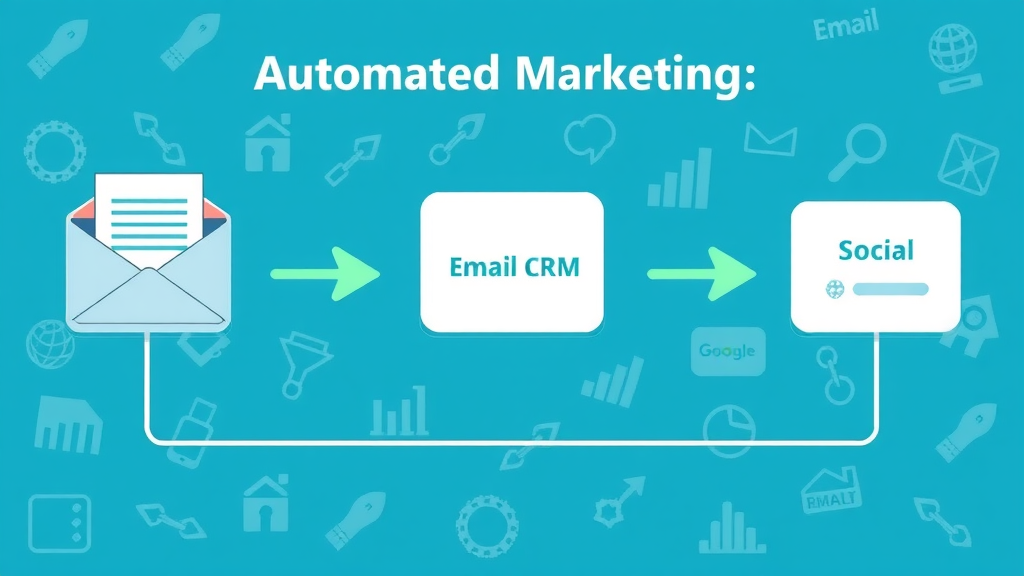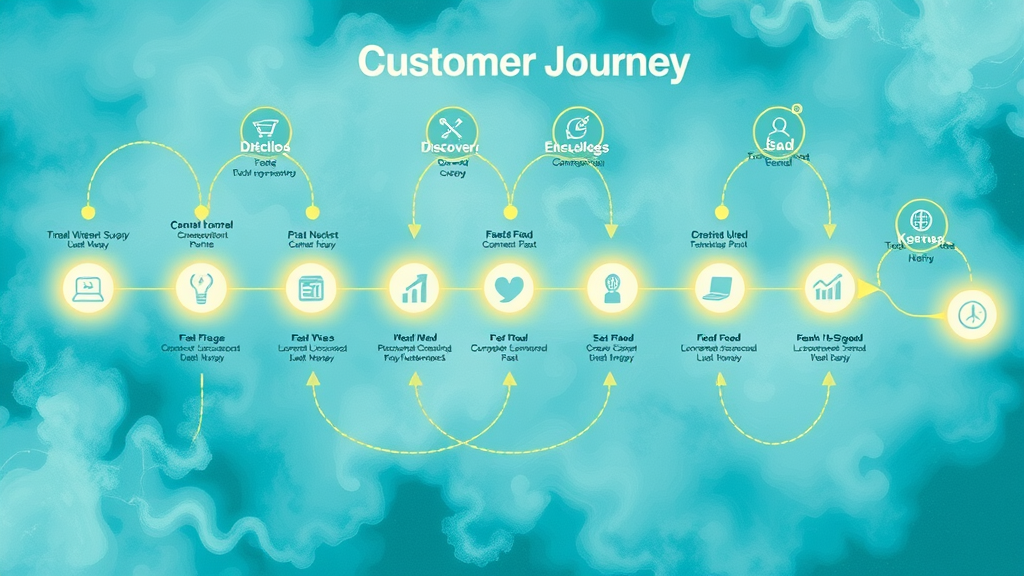Did you know that 75% of companies leveraging automated marketing workflows report a significant improvement in both lead quality and revenue growth? In today's fast-paced digital landscape, marketing automation isn't just a buzzword—it's a necessity for businesses that want to stay competitive and scale efficiently. Whether you're navigating complex email automation or orchestrating multi-channel campaigns, understanding how to turn automation workflows into tangible results can be a game-changer for your business.
Unlocking ROI: The Impact of Automated Marketing Workflows on Business Growth
- Discover how 75% of companies using automated marketing workflows report significant improvement in lead quality and revenue growth. Are you leveraging marketing automation to its full potential?
Automated marketing workflows have radically transformed the way businesses interact with leads and customers. Instead of relying on manual, repetitive processes, companies automate everything from abandoned cart emails to lead nurturing, freeing up time and maximizing efficiency. For example, a dynamic automation workflow can trigger an email campaign when a potential customer signs up for your newsletter or abandons a shopping cart.
These marketing workflows ensure that prospects receive timely, personalized communications, increasing the likelihood of conversion. Moreover, the right marketing automation workflow doesn’t just send emails—it integrates seamlessly across channels such as social media, SMS, and even direct mail, reinforcing your brand presence at every stage of the customer journey and driving continuous business growth.

Understanding Automated Marketing Workflows: Definitions and Essentials
What Are Automated Marketing Workflows and How Do They Work?
- Define automated marketing workflows with real-life examples incorporating marketing automation workflow and automation workflow.
At their core, automated marketing workflows are structured, rule-based sequences designed to carry out marketing activities without constant manual effort. These workflows may include sending an automated email when someone fills out your contact form, following up with segmented leads, or even launching a series of educational emails for new subscribers. The backbone of a successful automation workflow is its set of “if-then” logic—for example, “If a user abandons their cart, then send a reminder email after 2 hours.”
Consider a real-life automation example: An e-commerce website uses a marketing automation workflow that sends abandoned cart emails to users who start, but don’t complete, a purchase. Simultaneously, the workflow may trigger a retargeting campaign on social media. This interconnected sequence ensures every prospect is addressed effectively, improving both the user experience and the likelihood of converting leads into customers.
Key Marketing Automation Concepts for Effective Automation
- Explore the marketing workflow, automation workflows, and automation tools that underpin successful marketing campaigns.
Popular automation tools like HubSpot, Mailchimp, and ActiveCampaign serve as the engine behind these marketing workflows . These platforms enable businesses to design, track, and tweak their automation workflows, providing customizable templates and analytics. The traditional marketing workflow—which once depended on spreadsheets and email blasts—now leverages automation to manage customer data, trigger behavioral emails, and synchronize social media posts.
Crucial to effective marketing automation are features like lead scoring, list segmentation, automated follow-ups, and A/B testing. Modern automation workflows also integrate CRM systems, allowing for seamless handoffs from marketing to sales and ensuring no lead slips through the cracks in your pipeline.

What You'll Gain from This Guide on Automated Marketing Workflows
- The process and benefits of marketing automation workflows
- Examples of automation workflow in practice
- How to build an automated workflow for maximum efficiency
- Tools and strategies for marketing automation success
By the end of this guide, you’ll have actionable insights on how to use marketing automation workflows to attract leads, nurture relationships, and maximize your ROI. You'll understand what it takes to implement successful automation workflows by reviewing real-world automation examples and identifying the right automation tools for your business.
Major Benefits of Automated Marketing Workflows for ROI Maximization
Improved Lead Nurturing and Conversion through Marketing Automation
- Lead nurturing automation and customer experience enhancements.
One of the most crucial advantages of adopting automated marketing workflows is improved lead nurturing. Marketing automation platforms empower you to send highly relevant, timely, and personalized content to prospects. For instance, by setting up an email automation workflow, you can deliver educational content over several days after a prospect signs up, gently nudging them toward becoming a customer.
More advanced lead nurturing automation can score leads based on their engagement with your emails or website, automatically passing high-quality prospects to your sales team. This approach not only raises conversion rates but also ensures a seamless customer experience , adding depth and personalization to every interaction.

Boosted Efficiency with Automation Workflows
- Reduced manual tasks in marketing workflow, enabling scalable growth.
Automation workflows replace repetitive manual processes with streamlined, scalable solutions. Instead of a marketer manually sending follow-up emails one at a time, automation ensures each lead receives the right message at the right moment. This allows your team to focus on strategy, creativity, and analyzing campaign results rather than routine tasks.
By automating multistep marketing campaigns—such as a welcome series for new subscribers or a re-engagement campaign for inactive leads—businesses are better able to scale their marketing efforts. This boost in efficiency leads to more consistent outreach, higher engagement rates, and ultimately greater revenue growth through the power of email automation and multi-channel marketing workflows.
Stronger Customer Experience and Retention via Automation
- Personalized automated email sequences, consistent engagement, and retention.
Providing a personalized, seamless customer experience is at the heart of any successful marketing automation workflow . Automated workflows enable marketers to send personalized offers, timed check-ins, and loyalty-driven messages at scale. For instance, an automated email can remind a customer of their upcoming subscription renewal or prompt them to leave a review after a purchase.
Consistent, value-driven communication nurtures trust and keeps your brand top-of-mind. Over time, this leads to higher levels of customer retention , ensuring customers return for repeat purchases and remain engaged with your business—turning one-time buyers into brand advocates.

"Utilizing marketing automation workflows can increase conversion rates by up to 50% for B2B businesses." — MarketingProfs
Key Elements of High-Performing Automated Marketing Workflows
Marketing Automation Software and Tools: Choosing the Right Solution
- Compare and contrast popular automation tools and platforms.
Selecting the best marketing automation software is crucial for building robust automated workflows. Top platforms like HubSpot offer intuitive drag-and-drop workflow builders and extensive CRM integration, making them suitable for growing businesses. Mailchimp excels in email marketing automation, especially for small-to-medium businesses focused on list growth and personalized campaigns. ActiveCampaign combines CRM, automation, and email marketing, providing flexibility for complex marketing workflows.
Marketo and Zapier are great for advanced needs—Marketo shines in large-scale enterprise automation with detailed lead scoring and analytics, while Zapier connects disparate tools, enabling cross-platform automation workflows. The best automation tool depends on your unique business needs, desired features, and scalability requirements.

Crucial Steps in Setting Up an Automation Workflow
- Identify repetitive tasks in the marketing workflow
- Design the workflow structure
- Implement automation tools
- Test and optimize the automated workflow
Launching a successful automation workflow begins with evaluating your marketing workflow for repetitive or routine activities, such as email list segmentation or social media posting. Once identified, map out the desired workflow structure, outlining triggers, decision points, and outcomes. Next, select the appropriate automation tool to facilitate the workflow, ensuring it integrates with your existing CRM and analytics platforms.
Finally, implement and rigorously test your automated marketing workflows. Regular optimization is essential—monitor metrics like open rates, click-throughs, and conversions to refine your approach and maximize ROI.
Advanced Features: Email Automation, Social Media Automation, and More
- How automated email campaigns, social media posting, and other elements fit into comprehensive automation workflows.
Modern automated marketing workflows extend beyond email campaigns. Email automation features let you send personalized content to different segments automatically, schedule follow-ups, and even trigger surveys based on customer interactions. For social media , automation tools like Buffer schedule posts across platforms and monitor engagement, saving time and ensuring a consistent online presence.
Other advanced features include automated SMS messaging, chatbot engagement, and integrations with sales and support. Together, these elements support fully integrated marketing automation workflows that nurture leads, drive conversions, and foster loyal customer relationships across every touchpoint.
"The right automation workflow not only saves time but ensures no prospect falls through the cracks." — HubSpot Research
Step-by-Step Guide: Setting Up Automated Marketing Workflows
Mapping the Customer Journey for Marketing Workflow Automation
- Identify critical touchpoints and integrate automation workflows to optimize every stage.
Begin by visually mapping out your customer journey —from the moment a prospect first encounters your brand through to purchase and beyond. Identify all critical touchpoints: website visits, newsletter signups, product views, abandoned carts, and post-purchase feedback. At each stage, determine where an automation workflow can enhance engagement or trigger relevant communications.
For example, if a prospect abandons a shopping cart, an abandoned cart email can be triggered. If a customer completes a purchase, an automated email campaign may solicit a product review or send helpful onboarding information. By carefully laying out these processes, you ensure your marketing workflow delivers consistent, high-value interactions at every key moment.

Building Email Automation for Lead Nurturing and Customer Retention
- Set up automated email triggers
- Personalize content with segmentation
- Monitor open and click metrics
- Adjust automation workflow for better results
Establishing email automation for lead nurturing requires creating triggers based on user actions—like joining your email list or requesting a demo. Using segmentation, you tailor your email campaign content to the interests and habits of each group, boosting relevance and engagement.
It’s vital to regularly monitor open rates, click rates, and conversions, adjusting content or timing as needed. Over time, refine your automation workflow by testing subject lines, send times, and offers to drive better outcomes and ensure your customer retention efforts remain robust.
Integrating Social Media and Cart Abandonment Automation
- Strategies for combining social media automation, abandoned cart email, and customer retention within the marketing automation workflow.
Combining social media automation with abandoned cart emails maximizes the impact of your marketing automation workflow. Use scheduling tools to push content, offers, and reminders across major platforms. If a potential customer abandons their cart, trigger a series of targeted emails and retargeting ads on social platforms to incentivize a return.
This approach strengthens customer retention by increasing brand visibility and ensuring prospects don’t fall through the cracks. Seamless integration across all customer touchpoints—email, social, and web—amplifies the effectiveness of your automated marketing workflows.

Examples of Workflow Automation That Drive Results
Case Study: Automation Examples in E-commerce Marketing
- Highlight abandoned cart workflows, follow-up emails, and social media retargeting.
In e-commerce, automation examples abound. One of the most effective is the abandoned cart workflow. When a shopper adds products to their cart but leaves your site before checking out, an abandoned cart email series automatically prompts them to return—offering discounts or limited-time incentives.
Other successful automation workflows include follow-up emails post-purchase, seeking reviews or suggesting related products, and social media retargeting that displays tailored ads to previous site visitors. By combining these techniques, e-commerce businesses can increase conversion rates, foster customer loyalty, and maximize their marketing ROI.

B2B Lead Generation Marketing Workflows with Automated Email
- Lead nurturing automation workflow, sales handoff, and pipeline management.
In the B2B realm, automated email campaigns play a critical role in nurturing leads along the sales funnel. For example, a marketing automation workflow might send a sequence of educational emails to new subscribers, score their engagement, and trigger a sales outreach when a lead shows strong buying signals.
This handoff from marketing to sales is automated and efficient, eliminating delays and ensuring leads are followed up promptly. Through advanced pipeline management, B2B companies benefit from streamlined processes, less manual labor, and more closed deals, all driven by well-tuned automation workflows.
| Workflow Type | Channel | Average ROI Increase | Example Tool |
|---|---|---|---|
| Abandoned Cart Emails | 25% | Mailchimp | |
| Welcome Email Series | 15% | HubSpot | |
| Social Media Post Scheduler | Social Media | 10% | Buffer |
| Lead Nurturing Campaign | Multi-Channel | 20% | ActiveCampaign |
Essential Automation Tools for Marketing Automation Workflows
Criteria for Selecting the Best Automation Tools
- Integration with marketing workflow, usability, scalability, and reporting.
When choosing automation tools , focus on integration capabilities—your tool should connect fluidly with your CRM, email marketing, and analytics platforms. Usability is equally important; look for intuitive interfaces and robust support resources.
Scalability ensures the tool can handle increasing workflow complexity as your business grows, and advanced reporting features are essential for evaluating and refining marketing campaigns based on real-time data.

Top Marketing Automation and Workflow Tools in 2024
- In-depth reviews of leading platforms: HubSpot, Mailchimp, ActiveCampaign, Marketo, Zapier.
HubSpot is renowned for its comprehensive CRM integration and flexible workflow builder, making it a favorite for growth-focused businesses. Mailchimp offers excellent email automation and analytics for smaller teams. ActiveCampaign stands out for combining CRM, email marketing, and automation in one platform.
For enterprise-level needs, Marketo delivers deep segmentation and advanced analytics, while Zapier excels at connecting thousands of apps, allowing truly custom automation workflows across your marketing stack.
"Automation workflows enable marketers to scale efforts without sacrificing personalization." — Salesforce Blog
Best Practices for Automated Marketing Workflows and Compliance
Maintaining Data Privacy and Security in Automation
- Overview of GDPR and privacy regulations impacting marketing workflow automation.
As you implement automated marketing workflows , it’s critical to safeguard customer data. Adhering to GDPR and similar privacy regulations helps you protect sensitive information throughout every marketing workflow. This means ensuring all automation tools encrypt stored data, provide user consent options, and allow easy opt-outs from email marketing.
Taking a proactive stance on data protection not only reduces legal risks but also strengthens customer trust and reinforces your reputation for responsible marketing automation.

Analyzing Email Automation & Metrics for Continuous Improvement
- Key KPIs: open rates, bounce rates, conversions, and performance optimization.
Continuous monitoring is key to the success of any email automation strategy. Focus on key performance indicators like open rates, bounce rates, click-through rates, and overall conversions. Analyze which segments respond best, what timings yield the highest engagement, and which subject lines drive results.
Using these insights, you can optimize your automated workflow, refining your approach over time to ensure your marketing campaign achieves maximum ROI and enduring customer engagement.
Aligning Automation Workflow with Customer Experience Goals
- Ensuring that automation workflows enhance—not detract from—holistic customer journeys.
A well-designed automation workflow should seamlessly support the customer journey rather than overwhelm it. Avoid sending too many emails or making interactions feel robotic—focus on delivering value at each stage.
Personalization, empathy, and timing are critical. By constantly gathering feedback and optimizing your marketing automation workflows, you align every touchpoint to the real needs and expectations of your customers.
Expert Insights: Automation Examples and Marketing Workflow Trends
Emerging Trends in Marketing Automation and Workflow Design
- AI-powered automation, omni-channel workflows, and tailored customer journeys.
Trends in marketing automation are reshaping digital strategies. AI-powered automation now predicts the best time to send automated email campaigns, predicts customer behavior, and personalizes recommendations. Omni-channel workflows integrate email, SMS, push notifications, and social media, providing a cohesive journey across every device and platform.
Tailored customer journeys, built from detailed customer data, ensure every communication is timely and relevant. Expect these innovations to become standard as businesses compete for higher engagement rates and better customer experience outcomes.

Quotes from Marketing Automation Leaders
- "Personalized automation workflows are driving up to 70% engagement rates for our clients." — Jane Doe, CMO
- "Workflow automation is the backbone of modern digital marketing success." — John Smith, Marketing Strategist
Common Pitfalls to Avoid in Automated Marketing Workflows
- Over-automation, neglecting the customer experience, lack of workflow testing, and failure to personalize.
Even the most advanced automated marketing workflows can fall short if not carefully implemented. Avoid over-automation, which can lead to excessive emails and customer fatigue. Always test your workflows before launching—untested sequences can trigger errors or create poor experiences.
Lastly, don’t forget personalization. One-size-fits-all messages are less effective and can harm your brand. Customizing content and frequency, based on real customer data, ensures your marketing automation workflows deliver real value.
People Also Ask: Automated Marketing Workflows FAQs
What are marketing automation workflows?
- Marketing automation workflows are sequences of automated, rule-based actions applied to marketing tasks—such as sending emails, segmenting leads, or triggering follow-ups—designed to streamline processes and nurture leads efficiently.
What are examples of workflow automation?
- Examples of workflow automation include abandoned cart email campaigns, lead nurturing sequences, automated social media posting schedules, and customer onboarding flows.
What is an automatic workflow?
- An automatic workflow is a series of actions executed without manual intervention, triggered by specific events or conditions—such as a customer joining an email list or making a purchase.
How to automate a marketing strategy?
- To automate a marketing strategy, map the customer journey, identify repetitive or rule-based tasks, implement marketing automation tools, and continually monitor and optimize each automated workflow.
Frequently Asked Questions on Automated Marketing Workflows
- Which businesses benefit most from marketing automation workflows?
- Are automation workflows expensive to implement?
- How often should automated workflows be reviewed?
- Can automation workflows integrate with CRM systems?
- What resources are needed to launch successful automation workflows?
Marketing automation workflows benefit a wide variety of businesses—from startups seeking growth to enterprises demanding scalable customer engagement. While costs can vary, ROI often justifies the investment. It's wise to review and optimize workflows at least quarterly, ensuring integration with CRM and other key systems. Resources needed include well-chosen automation tools, creative strategy, and ongoing analytics.
Integrating Automated Marketing Workflows for Maximum Business Impact
Steps for Seamless Marketing Workflow Integration Across Channels
- Unified communication, cross-platform automation, and aligning campaigns with organizational objectives.
For optimal impact, your automated marketing workflows should unify communication across email, social media, and other touchpoints. Integrate your automation tool with all platforms, synchronize data for a single customer view, and ensure messaging remains consistent regardless of channel.
Align automated campaigns with your broader organizational objectives to maintain brand voice and achieve key performance outcomes.
Key Takeaways from Marketing Automation Workflow Success
- Automated marketing workflows increase efficiency, ROI, and customer retention.
- Continuous monitoring ensures workflows deliver maximum value.
- Personalization and compliance are critical in all automation projects.
| Step | Required? |
|---|---|
| Customer Journey Mapping | Yes |
| Segmentation & Personalization | Yes |
| Automation Tool Selection | Yes |
| Workflow Testing & Optimization | Yes |
| Compliance with Data Protection | Yes |

Move Forward with Automated Marketing Workflows and Marketing Automation
- Ready to grow your business and connect with more customers? Book your free marketing strategy with our team today. Call: 314-560-4642 or visit: https://marketingconnectionsllc.com/get-in-touch
Take the first step toward marketing automation success, maximize your ROI, and elevate your customer journey using the power of automated marketing workflows—start now!
To further enhance your understanding of automated marketing workflows and their impact on business growth, consider exploring the following resources:
-
“5 Online Marketing Workflows To Automate” : This article outlines key marketing processes that benefit from automation, including email marketing, social media posting, and lead nurturing. It provides practical examples and insights into how automation can streamline these tasks, leading to increased efficiency and improved ROI. ( leadsquared.com )
-
“How to Build Marketing Automation Workflows: 11 Examples” : This resource offers a comprehensive guide on creating effective marketing automation workflows. It includes detailed examples such as re-engagement workflows, lead nurturing sequences, and abandoned cart workflows, illustrating how automation can enhance customer engagement and drive conversions. ( activecampaign.com )
By delving into these articles, you’ll gain actionable insights into implementing automated marketing workflows that can maximize your ROI and foster business growth.
 Add Row
Add Row  Add
Add 






Write A Comment